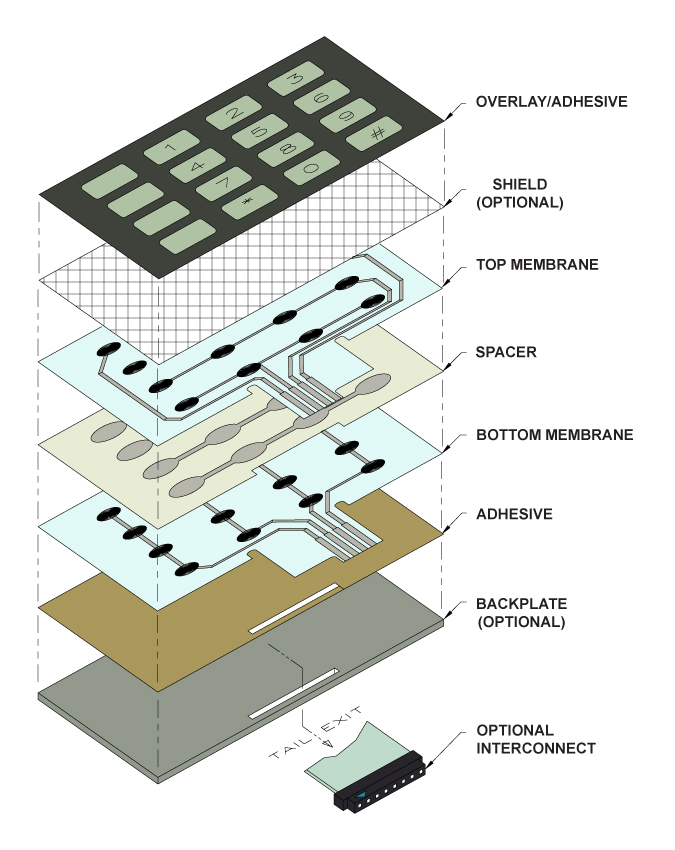Discover How a Membrane Switch Improves Durability and Capability in Tools
Discover How a Membrane Switch Improves Durability and Capability in Tools
Blog Article
Understanding the Functionality of Membrane Layer Switches for Individual Interface Devices
The capability of membrane layer changes stands for a significant development in customer interface style, integrating performance with visual flexibility. These buttons run via a multi-layered structure that converts individual communications right into electric signals, enabling both small layouts and durability against environmental elements. As sectors increasingly prioritize customer experience, understanding the nuances of membrane layer button innovation comes to be crucial. What ramifications do these improvements hold for future applications, and how might they redefine user interactions across different tools?
What Are Membrane Layer Buttons?
Membrane switches are cutting-edge interface devices that help with individual interaction with digital tools. These versatile components contain several layers, including a visuals overlay, spacer, and a published circuit layer. The design enables a seamless combination into different electronic gadgets, boosting both the aesthetic and functional aspects of interface.
Membrane buttons are typically employed in a large range of applications, from house home appliances to industrial equipment and clinical devices. Their building generally features a slim account, making them an excellent selection for portable styles. The responsive responses offered by these switches can be engineered to meet specific user choices, making sure reliable interaction between the individual and the tool.
Durability is an additional significant advantage of membrane buttons, as they are immune to dust, wetness, and chemicals, which enhances their life expectancy in demanding environments. Additionally, these buttons can be personalized in regards to shape, size, and graphic layout, allowing for branding and user-specific attributes. Generally, membrane layer switches over stand for a sensible remedy for enhancing individual experience in electronic gadgets, incorporating capability with aesthetic charm in an efficient fashion.
Just How Membrane Switches Over Job
Operating on an uncomplicated concept, membrane changes use a layered construction to register individual input effectively. Each button contains several layers, consisting of a published circuit layer, a spacer layer, and a top graphic layer, which are designed to interact seamlessly. When a customer presses the top layer, it presses the spacer layer, bringing the conductive elements of the circuit layer right into call with each other.
This get in touch with creates a closed circuit, signifying the device to carry out a details feature. The design permits numerous arrangements, consisting of tactile responses, which can enhance the user experience by offering a physical feeling upon activation. The materials utilized in membrane layer buttons commonly consist of adaptable substrates, such as polyester or polycarbonate, which ensure sturdiness and durability versus deterioration.

Key Benefits of Membrane Switches

Another considerable advantage is their density. Membrane layer buttons are slim and lightweight, which makes it possible for suppliers to conserve space in their devices without compromising capability. This function is specifically beneficial in applications where weight and volume are vital considerations.
Furthermore, membrane layer buttons are immune to dust, dampness, and chemicals, improving their durability. This resilience extends their life-span and lowers the demand for constant replacements, causing price financial savings over time.
Additionally, the tactile responses provided by membrane layer switches can be enhanced to enhance user interaction. They can consist of functions such as increased switches or audible clicks, improving use and customer experience.
Applications Throughout Industries
Customer interface gadgets utilizing membrane layer switches are prevalent in a vast array of sectors, showcasing their flexibility and performance. Membrane Switch. In the medical sector, membrane layer switches are important to gadgets such as diagnostic tools and individual monitoring systems, where their sturdiness and convenience of cleaning are crucial for keeping hygiene criteria. Likewise, in the auto market, these buttons are used in dashboard controls and infotainment systems, giving a sleek and contemporary user interface for customers.
In addition, the consumer electronic devices market take advantage of membrane layer switches in home Check Out Your URL appliances and portable tools, where small layout and easy to use user interfaces enhance individual experience. Industrial applications additionally take advantage of membrane switches for control panels in machinery and automation systems, highlighting their effectiveness and resistance to extreme environments.
In the aerospace and defense sectors, membrane switches are used in cabin controls and devices, where dependability and efficiency under severe conditions are paramount. In addition, the video gaming market progressively integrates membrane layer buttons in controllers and arcade makers, adding to an engaging individual experience. In general, the adaptability of membrane changes enables their prevalent use across many industries, highlighting their importance in contemporary interface style.
Future Trends in Membrane Switch Technology

In addition, the use of sophisticated products, such as polycarbonate and polyester movies, is expected to rise, offering improved sturdiness and resistance to environmental stressors. These products contribute to the total durability of membrane layer buttons, making them ideal for harsher industrial applications.
Furthermore, the unification of clever technology, consisting of IoT connectivity, will allow membrane layer buttons to communicate with other gadgets and systems, facilitating a more interactive individual experience. This pattern lines up with the expanding need for wise gadgets across various industries, from health care to customer electronics.
Finally, personalization options are anticipated to expand, allowing manufacturers to create bespoke solutions tailored to particular individual requirements and choices. These growths will certainly place membrane switches as essential components in the development of interface technology.
Final Thought
In verdict, membrane layer changes stand for a critical innovation in individual interface modern technology, providing a reliable and flexible option for diverse electronic applications. As innovations in material scientific research and touch sensing innovations proceed, the functionality and applicability of membrane switches are expected to increase, reinforcing their importance in modern-day digital devices.
Report this page